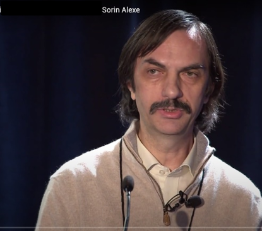Mathematical Sciences STEMinar Series
The objectives of the STEMinar Series are to explore research opportunities not confined to a single discipline and promote collaborative approaches leading to interdisciplinary solutions.
The ultimate goal is to set the stage for innovation by fostering the integration of ideas and opening new avenues for multidisciplinary research.
Quantitative Machine Learning for Stock Markets
Sorin Alexe, Ph.D. | QML Alpha, LLC
Friday, March 5, 2021

Abstract
Recently, there is an increased interest in applying Machine Learning and Artificial Intelligence to the construction of investment strategies. Here we introduce a Quantitative Machine Learning Platform for alpha discovery and strategy construction. There are three research layers that can help researchers finding signals that are hidden in large amounts of data:
- Interactive Design
- Machine Learning Tools
- Computer Simulations

The platform offers researchers tools for applying supervised and unsupervised Machine Learning techniques to large collection of data describing time-series systems, where uncertainty plays an important role. Modeling with a programming-free GUI allows researchers to focus on discovery of models based on discriminative and generative Machine Learning algorithms and integrate them in complex decision-making tools. A high level of automation is achieved via the definition of a structured search space and investigation of large samples of strategy candidates.
A brief introduction on portfolio construction will be followed by a demo session on alpha design. For those of you who become interested in learning more about quantitative investment and model construction we can provide access to use this platform to investigate new ideas, discover new models and apply hedging techniques to balance the reward to risk ratio.
Speaker Bio
Dr. Alexe holds a Ph.D. degree from Rutgers University, New Jersey in Operations Research. His initial research focuses on the design of totally polynomial time algorithms for the generation of maximal bicliques of a graph, later interpreted as biclustering algorithms. Another research direction consists of the design of fast algorithms for the generation of prime patterns in Logical Analysis of Data (LAD) and applying this inductive learning technique to design predictive models. The LAD method was initiated by Dr. Peter L. Hammer at RUTCOR, Rutgers Center for Operations Research, and it was and still is an important project of Operations Research in Machine Learning at Rutgers University. The LAD method was used as a Machine Learning tool to develop predictive models for various applied problems, in medical problems, genetics, economics and investments: heart diseases mortality rates, proteomics and microarray genetic data analysis for cancer detection, assessing country risk in sovereign credit evaluation and stock markets.
Dr. Alexe’s experience in the financial industry starts in 2004 with the implementation of the performance attribution module at Axioma. Since 2007, he changed his focus to forecasting the stock markets and he analyzed large datasets to create systematic strategies that are highly diversified. These strategies were implemented at top companies in this domain, among which WorldQuant and AQR Capital Management.
Dr. Alexe applied Machine Learning to create hundreds of alpha models, novel techniques for signal decomposition, model aggregation and risk control. All domain knowledge in Machine Learning and Stock Market was encapsulated within the Quantitative Machine Learning Platform for alpha discovery.
As part of disseminating these modeling platform, Dr. Alexe participated as co-adviser in academic projects involving students from Cornell Tech and Courant Institute, helping them to understand the type of problems they will face when, after graduation, they will be looking for a job in the financial industry.
Small Molecules with Big Dreams
Nasri Nesnas, Ph.D. | Biomedical and Chemical Engineering and Sciences, Florida Institute of Technology
Tuesday, September 10, 2019

Abstract
The world we live in is far too complex for humans to analyze. Yet our brains appear to have a corresponding level of complexity that can presumably be sufficient to better understand the world around us. For instance, a single human brain has far more neurons and interconnections (synapses) than roads and intersections across the entire world. How can the STEM fields work collaboratively to help map the complex pathways in the brain? In chemistry, we design small molecular tools that can be activated with light in some sense acting as small cameras “elucidating intersections,” which will enable a slow but gradual understanding of the complex brain’s network.
Speaker Bio
Dr. Nasri Nesnas received his Bachelor of Science as a dual major in chemistry and biochemistry at Manhattan College, New York, in 1994. He then pursued his graduate education earning two M.S. degrees and a Ph.D. degree in 1999, working with bioorganic chemist and University Professor Ronald Breslow, at Columbia University. Dr. Nesnas was a postdoctoral research fellow for nearly three years working with Natural Products Chemist, Centennial Professor Koji Nakanishi, at Columbia University.
Dr. Nesnas started his independent academic career at Florida Institute of Technology (FIT), in Melbourne, Florida, as an Assistant Professor in August 2002, and was promoted to the rank of Associate Professor in 2008, and to the rank of Professor in 2017. He was granted a National Institutes of Health (NIH) Award for his research in chemical neuroscience. He hosted 2 international professors, and mentored 11 PhD, 17 MS, 45 undergraduate, and 10 high school students over the past 17 years at FIT.
He received funds from NIH, NSF, NASA, Intel Corp., FSEC, and several local corporations. He authored and coauthored 29 refereed research articles with over 1200 citations, and also published 18 conference abstracts, 3 book chapters, and presented 46 invited lectures including the opening session for a Nobel Laureate in Budapest, Hungary, and a Plenary Lecture in Pisa, Italy.
Hyperbolic Materials and Metamaterials for Infrared Applications
Brain Lail, Ph.D. | Computer Engineering & Sciences, Florida Institute of Technology
Wednesday, April 24, 2019

Abstract
Light and matter can be strongly linked together to form coupled systems. Through material selection, this coupling can be tailored to achieve strong localized electromagnetic field enhancement. For visible light, surface plasmon polaritons (SPPs) result from the coupling along a metallic-dielectric boundary. However, at longer infrared wavelengths SPPs are not tightly confined so phonon polaritons, the coupling between the electromagnetic field and the lattice structure in a polar material, exhibit similar properties. Of particular interest is the generation of surface phonon polaritons (SPhPs) with hyperbolic materials. Hyperbolic metamaterials are artificial composite materials structurally designed to exhibit hyperbolic dispersion, which originates from one of the principle components of their electric or magnetic effective tensor having the opposite sign to the other two principal components. Hyperbolic materials can also be found in nature. Hexagonal boron nitride (hBN) is considered because it exhibits hyperbolic dispersion in the mid-infrared spectrum.
Basic mechanisms enabling the excitation of surface polaritons will be introduced along with coupled-mode theory. The integration of hyperbolic materials as well as two-dimensional metamaterials (metasurfaces) for infrared applications in hybrid waveguides, spectroscopy, and hyperlensing will be presented.


 Give to Florida Tech
Give to Florida Tech 